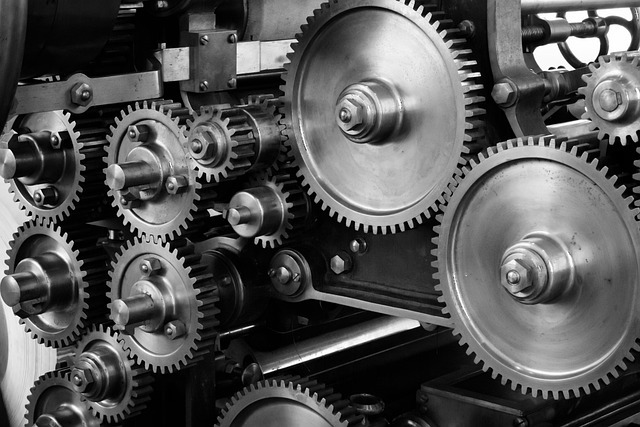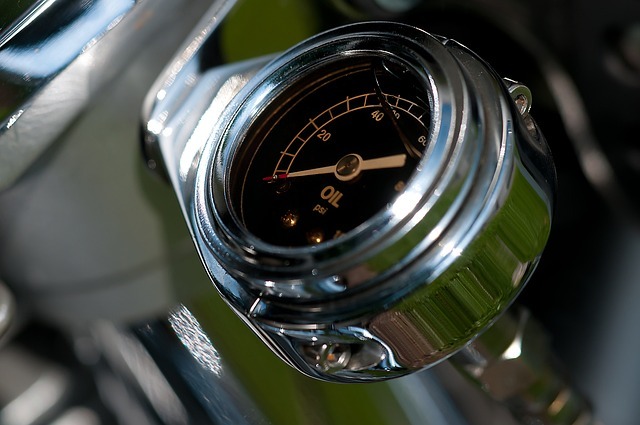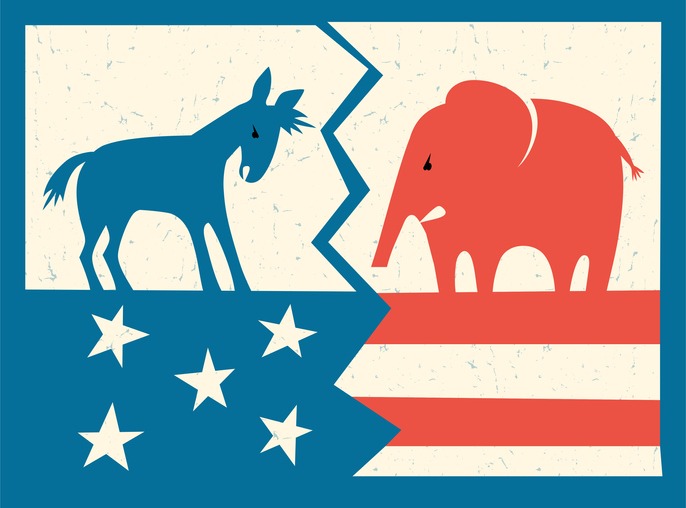“The political machine triumphs because it is a united minority acting against a divided majority.”
This quote from philosopher and historian Will Durant summarizes a reason for much cynicism toward our current political culture.
But for many, the other side or political party is always the object of that cynicism.
You’ll hear stories of how great their party is and how the opposing party is corrupt and greedy, and we must protect and fight against these opposing forces that will ruin and destroy our country.
That’s the political machines at work.
The united minority, usually the political parties, come together to deliver a message that hopefully will get votes from the divided majority so their brand can stay in power.
In my article Party Inc., I discussed how political parties are brands and the tactics used to expand those brands.
Here, we’re going to talk about how the inner workings of political parties turn them into political machines for control of the party, members, and votes and how this plays out in current events.
Hopefully, it will become clear how mechanical the parties can become and how these mechanical narratives will try to get our votes and influence public opinion during the election year.

Cogs in the Political Machine
The term political machine became notable after the Civil War and during the Gilded Age.
Those familiar with the era’s history will recall this type of local political machine in big cities like New York City, where they became associated with corruption.
Organizations like Tammany Hall, a Democratic political machine in late 1800s New York City, are the most well-remembered from this area as local organizations that helped win elections and control local politics in this corrupt way.
For us, though, we will focus more on how the current makeup of political parties represents the definition of political machines.
A political machine is traditionally defined as a group that works to win political power through the election of the members of their group.
Pretty standard definition when thinking about politics and political parties, which is the point, but they also involve a permanent structure, and that is where the mechanical nature comes into focus.
Political machines usually involve a leader or boss of some sort. The organization’s leader can set the agenda for the organization and, along with other high-ranking members, can decide who they want to represent the organization politically or who they will support.
We’ll talk more about how this works in the current political environment when we get to current events, but this is why the Gilded Age era and Tammany Hall are relevant.
Tammany Hall controlled who the local nominee would be and then, at times, would partake in more corruption like voter fraud and intimidation to win elections, accusations we hear of today on the national level from political parties.
Nevertheless, this structure from political parties of a leader and others who set the party agenda is notable because it so easily compares to the traditional definition of political machines and political machines of the past.
However, one prominent position within the parties that stands out in contemporary politics fuels the political machine: the political party Whip.
The Whip is a position whose goal is to get other party members in Congress to vote for the party’s agenda.
This means that if a member of Congress thinks of voting against the party’s position, the Whip will pressure that member to vote along the party line.
The Whip uses different tactics to try and achieve this.
They could promise a position on a committee if the Congress member does vote the party line or threaten to remove a member from a committee if they don’t vote the party line.
If the member of Congress still votes against the party line, they could be punished by the party. For instance, actually following through and removing them from a committee.
The party could also withdraw support from that member for the next election or put their support behind another candidate.
However, even though many members of Congress vote with the party’s agenda, there is more ability to break from this party vote in the United States.
Candidates in the United States raise a lot of money independently, allowing them to counter the potential disciplines.
For example, even if the party withdraws its support from a candidate or supports another candidate in the next primary cycle, the current member of Congress may have the money to continue to run their campaign.
This is enhanced if they have a strong record and have voted in a way the constituency agrees with.
Many times, when a Congress member votes against the party agenda, it is a way in which their constituency wants them to vote, and it is in the best interest of their district and state.
For example, if a Democrat votes against a piece of legislation the Democratic Party wants because their constituency does not like it.
In this case, the party is limited in its discipline. They could remove them from a committee, but overall, the Congress member will still be very popular among the consistency and will most likely continue to get elected if they are meeting the needs of the people.
Many party members will be ok with this in this instance, though, because if the Congress member is popular and continually getting elected, it’s better to have that member of Congress elected than someone from the opposing party.
Overall, we can see how the structure of the political machine is built.
And we can see how our current political parties follow this structure.
Next, let’s look at how this is currently enacted.

Well-Oiled Political Machines
With this year being an election year, the political machines will be out in full force for both parties.
And we can already see how the parties are starting to put the political machines in gear.
Let’s start with the Democrats and how they are using the political machine to spin the narrative around President Joe Biden.
Many are concerned with Joe Biden’s age, especially after the recent Department of Justice report calling Biden’s cognitive capacity into question.
But the response by the Democratic party says otherwise.
Kamala Harris responded to the DOJ report by criticizing it and saying it was “wrong on the facts” and “politically motivated.”
She also commented that President Biden was “on front and on top of it all” when commenting about his approach in meetings over the October 7th attacks on Israel.
Many others followed suit on news stations, making similar statements about how Joe Biden was mentally capable.
This may or may not be true, but what is true is this is the Democratic political machine in full swing.
The party’s boss is under scrutiny, so the political machines must go to work to address the issue.
The whole organization, the Democratic Party in this instance, will align under this narrative that Biden is capable, even if there is private doubt.
And we know there is doubt, but the public front will be one of his capabilities.
This contrived front makes people cynical towards them and why they seem so mechanical.
But whatever it takes to spread the Democratic brand and keep public opinion positive.
What Kama Harris and the Democrats should do is criticize the report but address that people have concerns with Biden’s age, and if you’ve seen otherwise, say that but also work to give people proof to assuage concerns.
And it doesn’t have to be a video of classified meetings, obviously, but put the President in positions where he can show his capabilities to the people, if he can.
Without proof and with only testimony from a biased source, you won’t convince anyone and will continue to look more fake and mechanical.
But, speaking of organizations that try to sell a point without proof, let’s get to the Republicans.
The Republican political machine is full steam ahead as well in support of their boss, Donald Trump.
Trump seems to be, as of this writing, on his way to the Republican nomination. And it’s around this that we see their machine in action.
After Trump won the New Hampshire primary election, he gave his victory speech. Behind him were Senator Tim Scott from South Carolina, Governor Doug Burgum of North Dakota, and others.
I point out Scott and Burgum because they were opponents of Trump a few months back in the primaries and are now nothing but loyal followers of Trump.
Scott, in particular, was right behind Trump as he gave his speech, and as he spoke, you saw Scott’s smiles, laughs, and applause. You could also make out Burgum doing this as well. It came across as incredibly phony.
At one point, Trump talked about Nikki Haley and said to Scott, “You must really hate her,” Scott replied, “I just love you.”
Opponents of Trump months earlier are now in full support of their boss because that’s how the political machine works.
Tim Scott presented himself as a Trump alternative in the primaries, someone of character who had a positive message for America.
Now, he’s smiling and laughing and cheering on Trump.
They’re all consolidating around Trump because they see him as the current boss of the Republican political machine.
Trump is even calling for a change of leadership in the Republican National Committee, which is the governing body of the Republican Party.
The chairman of the committee, Ronna McDaniel, is facing pressure to resign, and Trump is calling for three new members to head the committee, including his daughter-in-law, Laura Trump, to co-chair.
This would require approval from the RNC but would give Trump an even stronger hold on the party because he can put people more loyal to him in high positions of power.
And if this sounds exactly like the corrupt political machines of the Gilded Age, that’s because it pretty much is.
The irony in all of this is that the Trump wing of the Republican party spends most of its time calling for an end to corrupt American politics; at least, that is their public message.
But in the end, they’re using the same political tactics of cronyism and complete consolidation behind their boss to recreate the corrupt political machines of the past.
There are countless more examples of this with both political parties and far more to come as we move through the election season.
While there may be no way to avoid the political machines this election, recognizing their tactics and agenda will allow us to see political issues with better transparency.
It will also allow us to see the political parties for what they are: political machines whose most important goal is to expand their influence and brand.
